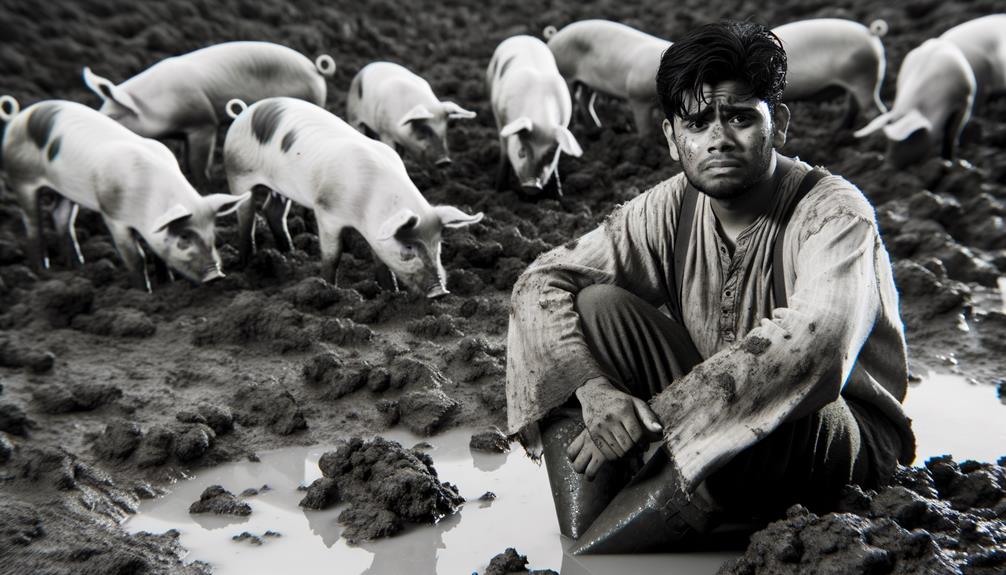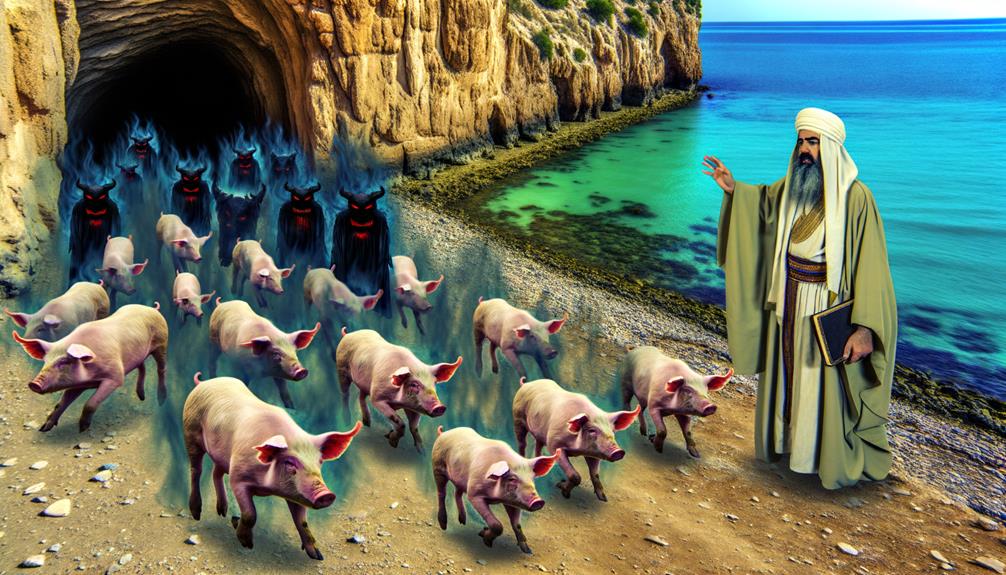Pigs in the Bible Meaning: Spiritual Insight
In Biblical texts, pigs are emblematic of impurity and moral decay. Levitical law in Leviticus 11:7-8 classifies pigs as unclean due to their non-cud-chewing nature, underscoring ritual purity requirements.
This symbolism extends to narratives like the Prodigal Son, where tending pigs signifies degradation and alienation. Additionally, in Matthew 8, Jesus’ exorcism of demons into swine further highlights pigs’ association with impurity. The depiction of swine in these contexts reinforces the overarching theme of moral and spiritual decay. Moreover, swine symbolism in biblical texts serves as a stark reminder of the dangers of straying from righteousness and the consequences of succumbing to sinful behavior. By using pigs to represent these negative qualities, biblical narratives encourage reflection on the importance of purity and redemption.
These references illustrate wider theological themes of moral rectitude and the distinction between sacred and profane. For a more thorough understanding of this symbolism and its cultural impacts, further exploration is essential.

Pigs in the Bible Meaning: Symbolism, Lessons, and Interpretations
| Reference | Context | Symbolism | Lesson or Insight |
|---|---|---|---|
| Leviticus 11:7 | Dietary laws in Old Testament | Unclean animal | Symbol of spiritual impurity |
| Matthew 7:6 | “Don’t cast pearls before swine” | Disrespect for sacred things | Discernment in sharing spiritual truths |
| Luke 15:15-16 (Prodigal Son) | Son feeding pigs in parable | Lowest state of sin | Need for repentance and return to God |
| Mark 5:11-13 (Demons into pigs) | Demons enter pigs and drown | Host of evil | Power of Jesus over unclean spirits |
| Isaiah 65:4 | People eating swine’s flesh | Rebellion against God | Warning against disobedience |
Pigs in Levitical Law
In the context of Levitical law, pigs are deemed unclean animals, strictly forbidden for consumption by the Israelites as stipulated in Leviticus 11:7-8.
This passage categorically states that although pigs have a split hoof, they do not chew the cud, thereby rendering them impure. Such dietary regulations are part of a broader framework designed to maintain ritual purity among the Israelites.
These laws served not merely hygienic purposes but reinforced a distinct cultural and religious identity. The prohibition against consuming pigs reflects a symbolic demarcation between the sacred and the profane, guiding the Israelites in their covenantal relationship with God.
Consequently, adherence to these dietary restrictions was integral to communal sanctity and spiritual obedience.
The Prodigal Son’s Journey

The narrative of the Prodigal Son‘s journey, as found in Luke 15:11-32, offers profound symbolic meaning through his departure to a distant country and subsequent destitution that led him to feed swine.
This contextually rich parable utilizes the imagery of pigs, considered unclean in Jewish tradition, to underscore the son’s fall from grace and ultimate repentance.
Leaving for Distant Country
When the prodigal son decides to leave for a distant country, his journey symbolizes a deliberate departure from familial and spiritual security in pursuit of self-indulgence and materialism.
This act of leaving represents a broader theological theme of free will and the human propensity to seek fulfillment outside divine guidance. The distant country is not merely a geographical location but a metaphor for spiritual estrangement and the allure of worldly pleasures.
By abandoning his father’s house, the son effectively rejects the values and teachings that formerly provided him with stability and purpose. This narrative serves to illustrate the consequences of prioritizing immediate gratification over lasting spiritual fulfillment, a common motif in biblical literature concerning human fallibility and redemption.
Feeding the Swine
As the prodigal son squanders his inheritance and finds himself destitute, his subsequent employment feeding swine underscores his profound degradation and alienation from his former life of dignity and spiritual integrity.
Within the Jewish cultural context, pigs were considered unclean animals, symbolizing the lowest form of impurity and moral decay. By tending to swine, the prodigal son not only faces economic destitution but also experiences a profound spiritual and social exile.
This role reversal—from a privileged heir to a caretaker of unclean animals—highlights his complete fall from grace. The imagery of feeding swine serves as a poignant metaphor for his internal and external desolation, setting the stage for his eventual repentance and return to the father’s embrace.
Jesus and the Demons

In the Gospel accounts, the episode where Jesus exorcises demons from a possessed man and permits them to enter a herd of swine offers profound theological and socio-cultural insights.
The demons’ plea to Jesus underscores their recognition of His authority, while the subsequent drowning of the pigs illustrates the destructive nature of demonic influence. This event also had significant repercussions for the local villagers, highlighting the economic and communal impact of Jesus’ miraculous acts.
Demons’ Plea to Jesus
During the encounter between Jesus and the possessed man in the area of the Gerasenes, the demons’ plea to Jesus to be cast into a herd of pigs reveals significant theological and symbolic dimensions.
This request underscores the acknowledgment of Jesus’ authority by the demonic forces, illustrating His supreme power over spiritual entities. Moreover, the demons’ choice of pigs—animals considered unclean in Jewish culture—highlights the inherent impurity associated with them.
This interaction not only emphasizes Jesus’ role as a divine exorcist but also serves as a powerful metaphor for the expulsion of evil.
Herd of Swine
Illustrating the dramatic culmination of the encounter, the narrative of the herd of swine being possessed by the demons and subsequently plunging into the sea serves as a profound indication of the consequences of spiritual turmoil and the purging of evil.
This episode, found in the synoptic Gospels, especially Mark 5:1-20, underscores the authority of Jesus over demonic forces. The choice of swine, considered unclean in Jewish dietary laws, symbolizes the impurity being cast out.
The self-destructive plunge of the swine into the sea further signifies the ultimate fate of evil when confronted by divine power. This act not only demonstrates Jesus’s capacity to restore order but also provides a vivid illustration of the tangible effects of spiritual deliverance.
Impact on Villagers
The dramatic exorcism of the demoniac and the subsequent destruction of the swine had a profound and multifaceted impact on the local villagers, revealing the complexities of their reaction to Jesus’s miraculous intervention.
On one hand, the villagers witnessed an unprecedented act of divine power, potentially affirming Jesus’s spiritual authority.
On the other, the loss of the swine, a valuable economic resource, likely elicited fear and resentment. This duality underscores the tension between spiritual salvation and material loss.
The villagers’ subsequent plea for Jesus to depart their region highlights their struggle to reconcile the miraculous with the practical, reflecting broader societal challenges in integrating transformative spiritual experiences with everyday economic realities.
Symbolism of Impurity

In biblical texts, pigs are frequently depicted as symbols of impurity, reflecting broader cultural and religious norms about cleanliness and sanctity. This portrayal is evident in various scriptural references where pigs are associated with uncleanness and sin.
For instance, Leviticus 11:7-8 explicitly categorizes the pig as unclean, forbidding its consumption. This symbolic association underscores a dichotomy between purity and impurity central to Judaic law. The following table captures these scriptural references and their implications:
| Scripture | Reference | Implication |
|---|---|---|
| Leviticus 11:7-8 | Dietary Laws | Prohibition of consumption |
| Isaiah 65:4 | Ritual Impurity | Living among tombs, eating pigs’ flesh |
| Matthew 8:30-32 | Demonic Affliction | Demons cast into swine |
These texts illuminate the enduring symbolic role of pigs as embodiments of impurity.
Cultural Contexts

How does the cultural milieu of ancient Near Eastern societies inform the biblical depiction of pigs as symbols of impurity?
Within the ancient Near Eastern context, pigs were often associated with filth and uncleanliness, both physically and symbolically. Many neighboring cultures, such as the Egyptians and Mesopotamians, regarded pigs with disdain, reinforcing their negative connotations.
This cultural perspective is mirrored in the Hebrew Bible’s dietary laws, particularly in Leviticus and Deuteronomy, which explicitly categorize pigs as unclean animals.
Additionally, the socio-economic conditions of these societies, where pigs were commonly scavengers, feeding on refuse, further contributed to their impure status. This cultural milieu underscores a broader framework within which biblical texts situated pigs, embedding them in a narrative of impurity and exclusion.
Theological Lessons

Biblical prohibitions against consuming pigs serve not only as dietary guidelines but also as profound theological statements about purity, covenantal identity, and the demarcation of sacred community boundaries.
The Levitical laws, specifically in Leviticus 11:7 and Deuteronomy 14:8, articulate these prohibitions, embedding them within a framework of holiness and separation from the profane. This demarcation underscores Israel’s distinctiveness among nations, reinforcing their unique relationship with God.
The pig, considered unclean, symbolizes the broader concept of ritual impurity, which could defile the community’s sanctity. By avoiding such animals, Israelites affirmed their commitment to the covenant and adherence to divine ordinances, fostering communal cohesion and spiritual integrity.
This theological lens offers profound insights into ancient Israelite identity and religious practice.
Modern Interpretations

Contemporary perspectives on the biblical prohibitions against consuming pigs reveal a complex interplay between ancient religious mandates and modern cultural, ethical, and dietary practices. In today’s globalized world, interpretations vary across religious, secular, and health-conscious communities. The prohibition is seen by some as a historical relic, while others uphold it for spiritual discipline or health reasons.
| Aspect | Modern Interpretation |
|---|---|
| Religious Adherence | Continuation of dietary laws for spiritual purity |
| Health Concerns | Avoidance of pork due to perceived health risks |
| Ethical Considerations | Animal welfare and environmental impact of pork production |
| Cultural Practices | Retention or adaptation of dietary customs |
| Secular Views | Academic and historical analysis of ancient dietary laws |
This diversity underscores the dynamic nature of religious and cultural beliefs in contemporary society.
Conclusion
To conclude, the role of pigs in the Bible is multifaceted, encompassing Levitical laws, parabolic teachings, and symbolic meanings of impurity. Contextually, pigs serve as a vivid illustration of cultural and theological dichotomies.
The adage ‘one man’s trash is another man’s treasure’ encapsulates the varying perceptions of pigs, highlighting their complex symbolisms.
The study of pigs within biblical texts reveals deeper insights into ancient societal norms and enduring theological principles, reflecting a rich tapestry of interpretative layers.






